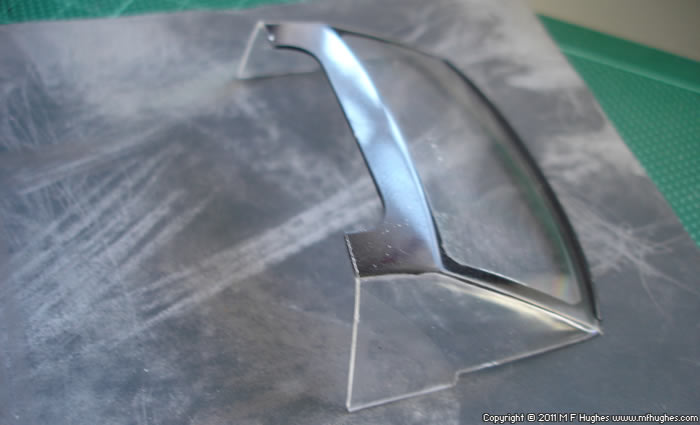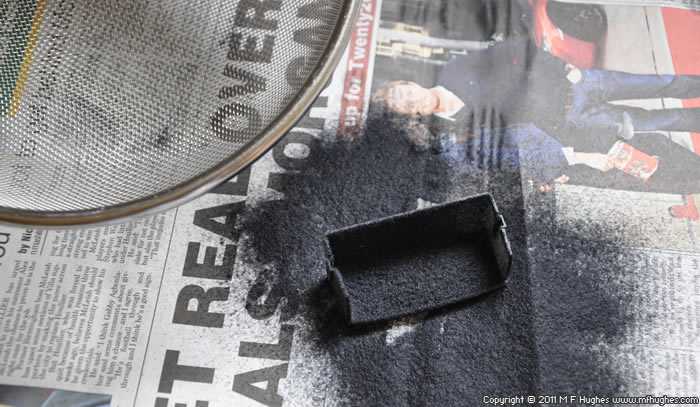VIP Car tutorial : Aoshima Admiration Toyota Celsior 1/24. | Model Kit Index
This tutorial is for a Toyota Celsior VIP car, in this case, the Aoshima Admiration Celsior. In every case, comments refer to the photo directly above the comments. I've tried as much detail as possible within both the photos and descriptions, so if you're reading something you already know, just skip ahead.
Gallery of completed Kit.
Part 3 : The interior part 2

The inside of the window parts were drawn over with a 2B pencil at the border of the plain glass and the frosted glass - indicating the edge of the window mask. The area was coated by Tamya masking tape - a technique I'd used on the last 4 cars I've built. So there's no reason to think it would go wrong this time was there?

The pencil line is easily visible through the tape, so a sharp knife could score over the line and the excess tape was removed.

The fullt prepared window masks.

The windows were spray painted with matt black from the inside to make the black look perfect from the outside as seen above.

Upon removing the tape, I discovered some sticky residue left on one third of the front windscreen (A) . I'm not sure why this occurred, the same tape was used throughout. Anyay much to my frustration, none of the following solvents removed it: Water, Olive Oil, Enamel Thinners, Acrylic Thinners, Methylated spirit, medical adhesive remover, nail varnish remover, turpentine, white spirit. None of them damaged the rest of the glass either, which is useful to know for the future. Closer inspection reveals that this wasn't just sticky residue - it had actually physically attacked the glass, and so it will never ever come off. What to do?

I decided to buy a donor car from Ebay, froma seller in Hong Kong. I choose the cheapest Aoshima Celsior they have, £20 including delivery. This will be the donor car for just one part - the glass. When it arrived I was glad I didn't buy it for the whole model - the body is about as warped as you can get without coming back on itself. After some inspection I notice this new Celsior is the Facelifted model, where as the Admiration Celsior I'm working on is the pre-facelift model. This version also does not have an opening boot. The glass fits pretty close, though not 100% perfectly. The Chassis and interior are common to both models but not the body. It also seems that because of the opening boot on the Admiration version, the plain version has a longer lip at the bottom of the rear window, which is incompatible with the boot opening mechanism. I had a choice here, I could file off the lip, or do something else entirely.

I decided to go with an earlier idea I had- semi open windows. To begin with I marked onto the glass where the small rear quarterlight divider runs. Any glass behind this was part of the original piece, with correct boot fitment and no lip. I can use this as it was undamaged by the masking tape.

For this job I need a very fine tooth plastic saw from Hobbycraft.

The first side at two stages of cutting. The last 0.5mm is cut with the knife.

The rear glass finally removed.

Using the remaining glass as a guide, I cut paper templates for the side windows

From the lid of a cream cake box, I obtained enough plastic to make the side windows. The good thing about using this plastic is that it's thin enough to give a correct scale appearance to the semi rolled windows. The kit's actual moulding would be about 2cm thick in real life - the kind of glass you only find on bulletproof cars. Since you never normally see the glass from the edge, it's not a problem but since these windows are to be half rolled down, this will look much better. The cake boxes plastic do vary in quality, some looks as rough as old glass. However in this instance, it was perfect.

The final windows, which also contain cutouts for the door handles so when they're stuck inside, they will fit flush.

I was not looking forward to the next step - cutting my precious new windscreen. I mark on lines with a permanent pen where the cuts needed to be made. Across the top with a saw (B) and down the sides with a knife (A).

From the inside, I scribed over and over the lines along the A-pillar and roofline with a craft knife with a brand new blade, until eventually the plastic parted. This was repeated on the other side. Each side took about 30 minutes. The awkward angle of the cuts meant I could not use the saw. I dislike working with transpaernt parts at the best of time, but it came out as I'd imagine without cracking.

After both sides were complete, I could at least use the saw scross the roof, and shown above is the final removed windscreen. A whole new £20 kit for this one small but critical part!

Taking no chances with the tape again this time, I painted the front window masks by hand using matt enamel. It takes two coats onto this plastic to give a decent level of opacity.

As seen on the photos above, curtains are a popular accessory on VIP cars. I will create these for mine, but in beige to match the rest of the interior. I'm tired of black interiors on models. It seems sometimes half the car is just all semi-gloss black. Beige is easier to photo too.

For the curtains, I used some beige card, a knife and metal ruler, plus a little masking tape.

By working the card back and forth over the edge of the ruler, I made a concertina shape - a series of Zs until I'd got as many folds as I needed.

A slot in the last section was cut to provide access for the tape tie-back, and this is made simply from a strip of masking tape. One completed curtains is shown on the right. I then made 3 more just like this.

The completed curtain halves were fit tested against the Celsior's B-pillar and then taped together as pairs, shown on the right

The completed curtains are spray painted with Ford Tuscan Beige and flattened with Mr Hobby Flat Matt topcoat.

After spraying the inside of the boot matt black, wood glue (white glue) was applied with an old crappy brush. This will then be flocked with Hiroboy black flocking.

The flocking was sieved over the boot and gently pressed in place with a finger.

The completed boot interior. It was left to dry for a long time, otherwise flocking seems to come off quite easily geting everywhere. It still comes off now if you bang it hard enough.

At this point I realised that without any sturdy moulded side windows, there would be nothing for the door mirrors to stick to. From a piece of plastic sheet I prepares some mounts for the mirrors.

The mountings were glued from the inside and the mirrors then attached from the outside. All good.

Everything was now attached to the inside of the car body using black electical tape. It might not be that pretty here, but after assembly it won't be seen.

Another popular VIP modification is the Fusa Knot (A) and Tsuna knot (B). I decide to replicate the Fusa knot with wire, which holds it shape and position better than cotton thread. I have a roll of thin wire from Hobbycraft. First some staple-like loops are made (shown on the far right) and several of these are twisted into a longer strip to make sure they can't come loose. These will be the hanging part of the fusa knot.

After some more wire bending which I made up as went along, using the photo for reference, the fusa knot was complete. It might not look that much here but once it's mounted inside the car, it's a whole lot better.

I also made a Tsuna knot using the photo as a reference for how it's tied together. However it's quite large and obvious and maybe just a bit too bling for me, so this is not put into the completed model kit. It'd would also be a bugger to mount as being made from elastic, it won't sit or glue where you want it to.

The sun visors are made from cardboard, cut to shape using the old interior as a reference.

The front facing parts of the visors were covered with the same sticky cloth used for the carpets.

Superglue is the only thing that'll stick the cardboard to the roof lining, and blu-tack is the onyl thing that'll hold the Fusa knot to the sun visors, which also nicely hide the blu-tack.

Various parts of the interior were painted beige including the wide C pillars, which are quite visible from the outside of the car. The inside of the sun visors is also painted beige and at (A), a small rectangle of sticky chrome is applied to the inside of the passenger visor, to make the vanity mirror. The second part of the interior is now complete.
All content, text & graphics Copyright © M.F.Hughes 1995 - | Home | More Kits



































